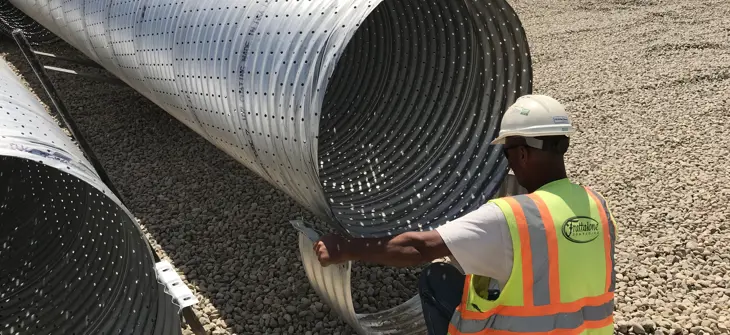
What’s the Difference between Detention and Retention?
Contech has published several blog posts that refer to corrugated metal pipe (CMP) for underground storage of stormwater. We were a bit surprised when some engineers challenged our use of the word detention. Two different engineers commented on LinkedIn that the proper term to use was retention, not detention. Based on these comments, we thought it would be a good idea to explore the meaning of these terms and how they are used to describe stormwater management activities.
Detention Vs. Retention
Why the confusion? In terms of stormwater BMPs, the reason detention and retention are often interchanged in that both refer to methods of controlling flooding and erosion by managing the quantity of stormwater. However, the terms have very different meanings.
By definition, a detention BMP is an area where stormwater is temporarily stored, or detained, and is eventually allowed to drain slowly when water levels recede in the receiving channel. On the other hand, retention stormwater BMPs hold or retain stormwater on a more permanent basis. The best illustration of this difference between the terms is a dry pond (detention) and a wet pond (retention).
Dry ponds, as the name suggests, are usually dry except during or after rain events or snowmelt. They are meant to slow down the flow of stormwater and keep it for a short time. Wet ponds, on the other hand, have a permanent pool of water that rises and drops depending on the runoff coming from contributing areas. Wet ponds are designed to keep deposited sediment at the bottom and discourage resuspension.
The problem with ponds is that they take up valuable land space. This is not a major issue in rural areas, but in urban environments where land space is limited and expensive, the use of ponds is simply not an option. That’s why companies like Contech and other manufactured BMP providers have developed underground storage solutions that provide many of the benefits of landscape-based systems but without requiring dedicated land area, thus maximizing the land value for the owner.
So far so good. But here is when things can get a bit confusing, as underground systems can be either retention or detention systems.
The majority of underground systems are considered to be detention systems. A good rule of thumb is that any system designed with an underdrain or outlet that slowly releases the water downstream is typically a detention system, while a system that is designed to permanently retain water onsite, typically via infiltration, is a retention system. Underground storage systems such as corrugated metal pipe (CMP) are considered detention systems as they are designed to hold a specific volume of water and release it slowly over time. If the system is configured to allow for infiltration, such as a perforated pipe or chambers, it would then be considered retention, since the water is being retained onsite. It is also common to have systems that do some of both. For example, a site with tight soils it might only be possible to retain a portion of the water runoff while the rest is detailed and eventually released downstream.
There are several jurisdictions that allow underground wet ponds, which is simply an underground storage system with a permanent pool of water. These are not very common, but by definition, these should be referred to as detention systems unless configured to infiltrate. A good rule of thumb for distinguishing these types of systems is to remember that detention is temporary but retention is intended to be permanent.
